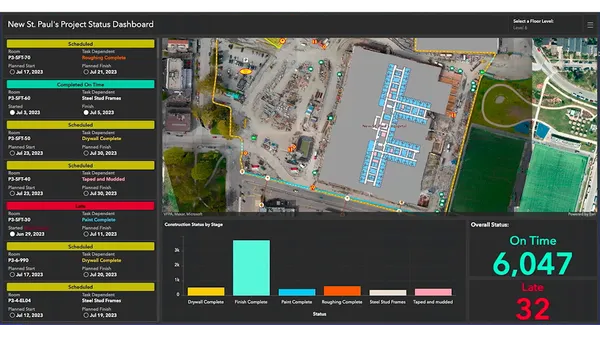Technologies like BIM, drones, virtual reality and real-time workflow software have made an entrance that will forever alter the scope of the construction industry. Every few weeks, Construction Dive provides a roundup of the latest technology product announcements that promise to boost productivity by saving contractors time, money and labor. To view the entire series, click here.
Autodesk streamlines InfraWorks integrations
Autodesk recently announced an update to its infrastructure planning and design software InfraWorks. According to the company’s website, the new rollout is intended to tighten integrations with Autodesk’s BIM 360 software and geographic information system (GIS) data.
The update’s new features primarily grant users the ability to create more bridge types with features such as piers, abutments and girders; preview ArcGIS data through an Autodesk integration before importing that data to a new or existing Infraworks model; manage data on the Desktop Connector hub, which syncs to BIM 360 or Autodesk Drive; and access more home menu tools. Some of the home menu improvements include status icons to indicate if a model is locked or disconnected and the capability to create a duplicate model.
MIT brings lifecycle analysis to early planning phase
Researchers at the Massachusetts Institute of Technology have developed a lifecycle analysis (LCA) tool that can be implemented early in a project’s planning phase, MIT announced.
According to the American Institute of Architects (AIA), LCA assessments look at energy use and other environmental impacts associated with each phase of a building -- procurement, construction, operation and decommissioning.
To calculate LCA, the MIT researchers’ system considers factors like the building location’s climate; building dimensions and orientation; ratio of walls to windows on each side; materials used for the walls, foundations and roofing; and heating and cooling systems used.
While LCA is typically measured after the building is built, MIT’s tool would bring this assessment to the design and planning phase. The research team found that doing so did not reduce the range of choices available to designers, according to MIT.
Although intended as a tool for reducing a building’s climate impact, it also can be used to optimize a building based on other goals, such as minimizing cost, the researchers said. It is currently designed as a standalone tool, but the researchers hope to make it a plug-in for other commonly used software tools.
Vectorworks 2019 boosts speed, user experience
BIM and CAD design software provider Vectorworks rolled out the 2019 version of its products, which include tools for 2D and 3D drafting and modeling, presentation workflows, structural performance analysis and more.
Vectorworks 2019, according to a company press release, aims to enhance software performance and user experience. “[W]e concentrated on our customers’ most common workflows and usage patterns to increase their overall productivity,” CEO Dr. Biplab Sarkar said in a recent announcement.
Vectorworks said users can expect “faster workflows and improved software performance” as a result of multiple core support -- which increases computing power -- in the Graphics Module. Vice president of product development Steve Johnson said in the press release that Vectorworks 2019 users will see files open four times faster than the previous version.
New search and filter options and image effects are also included in the release. For example, users will also be able to refine images and renderings within the software, he said, without the need to export to Adobe Photoshop. Vectorworks 2019 is available across Landmark, Spotlight, Architect, Fundamentals, Designers, Braceworks and Vision platforms.
Building Intelligence expands insurance documentation tool
Designed to manage relationships between vendors, tenants and facility operators, the SV3 Insurance Certificate Tracker 2.0 from Building Intelligence Inc. can now be used as a standalone tool.
According to a statement from the company, the application uses cloud-based technology to automate the process of managing authorization and entry permission so that administrators can upload, share and track insurance certificates in a central location.
Facility managers can also give contractors, tenants and other administrators access to an online service to manage documentation of insurance certificates, according to the company. This, in turn, can streamline the process of collecting, authorizing and ensuring that required insurance certificates are in place, the announcement said.












